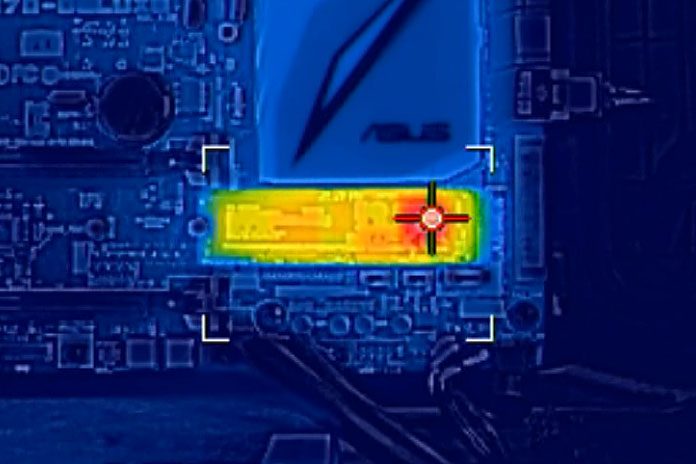M.2 SSDs are pretty awesome. They pack loads of solid-state storage onto a circuit board that’s about the size of a large stick of gum, and they keep a low profile by plugging directly into the motherboard. They’re incredibly fast, too; the best drives have PCIe x4 interfaces and push transfer rates up to around 2500MB/s!
There’s just one problem: some drives can’t maintain top speed without overheating, which triggers thermal throttling that reduces performance to prevent damage. This protective mechanism keeps your data safe, an admirable trait, but it also sacrifices one of the key benefits of upgrading to M.2 storage. And that kind of sucks.
While numerous tech sites have demonstrated throttling on M.2 drives, a couple of investigative blog posts at Puget Systems shed new light on how different system configurations and loads affect the outcome. They show that the location of the M.2 slot on the motherboard makes a big difference, especially when nearby graphics cards are under load, and they illustrate that U.2 SSDs with similar performance are immune to thermal-induced throttling. These findings vindicate the decisions we made when implementing PCIe storage on our motherboards.
If you want the full story on M.2 performance throttling, be sure to read Puget’s in-depth analysis of Samsung 950 Pro and its companion piece on how auxiliary cooling can mitigate the impact. We’re going to focus on how the results relate to ASUS motherboards.

Puget Systems did most of its testing on our Z170-WS, which has M.2 slots below the primary PCIe x16 mid-way up the board and below the secondary slot toward the bottom. They also tested the vertical M.2 slot on our X99 Deluxe, a unique configuration mirrored in the new X99-Deluxe II, and the underside slot on our H170I-Plus D3, a typical location for Mini-ITX motherboards with insufficient space topside.
The big news is that 950 Pro was unable to sustain its peak sequential speed in all four locations, regardless of whether the system was idling or occupied with a heavy graphics load. Throttling kicked in after as little as seven seconds of sustained testing or as much as 70. The declines were significant, too: from 40-70% with a single graphics card and 55-76% with two. Matt Bach, who conducted the testing and has previously demonstrated throttling on the 950 Pro and other Samsung M.2 SSDs, was particularly surprised by how quickly the new drive throttled in thermally challenging environments.
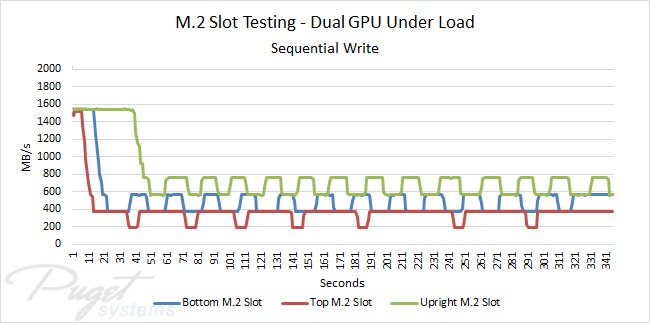
The worst-case scenario was the drive in the top M.2 slot, surrounded by dual graphics cards under load. No surprises there. Throttling took about twice as long to limit performance with the 950 Pro in the bottom slot. As you’d expect, both configs fared much better with only a single graphics card installed. Most of our recent motherboards put the M.2 slot on the bottom, even closer to the right edge than on the Z170-WS, which moves drives a little bit farther from potential hot spots and should stave of throttling a little while longer.
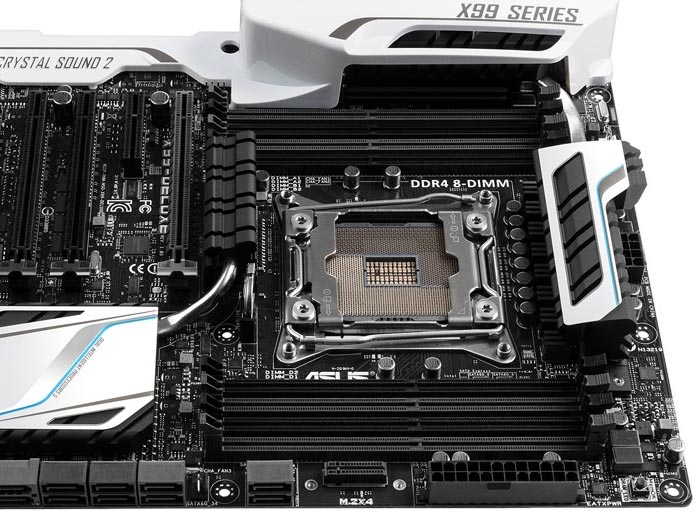
By far the best location was the upright slot on the X99-Deluxe. This vertical orientation allows more airflow around the drive, resulting in longer throttling delays—and often smaller speed reductions—than the other motherboard slots. The upright config was also less affected by graphics loads and the presence of a second card.
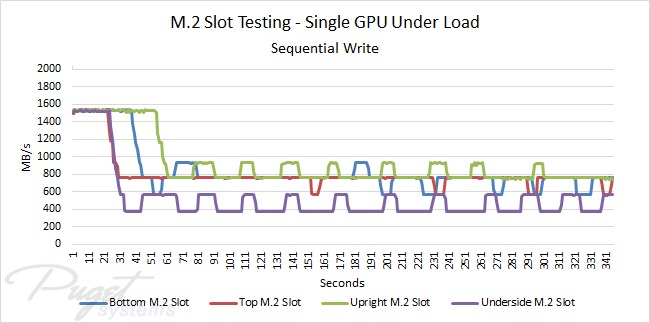
The underside slot has less airflow than any of the other positions. Predictably, the 950 Pro exhibited the most severe throttling in this location—and the biggest performance hit with a single graphics card under load. This is especially problematic because Mini-ITX motherboards typically don’t have room to put their M.2 slots anywhere else. The only other option is the PCI Express x16 slot, which is usually reserved for a graphics card
When designing our Maximus VIII Impact, we had to choose between an underside M.2 slot and a native U.2 port. Offering both would have required extra layers, inflating not only the cost of the board, but also the development time required to bring it to market. Since the Impact is all about bringing the best performance to Mini-ITX, we went with U.2 to avoid throttling issues that had been documented with other M.2 drives at the time. We caught some flak from people who wanted to build Mini-ITX rigs with M.2 drives, but Puget’s results support our decision. The 750 Series U.2 SSD showed no signs of temperature-induced throttling in any of the tests.
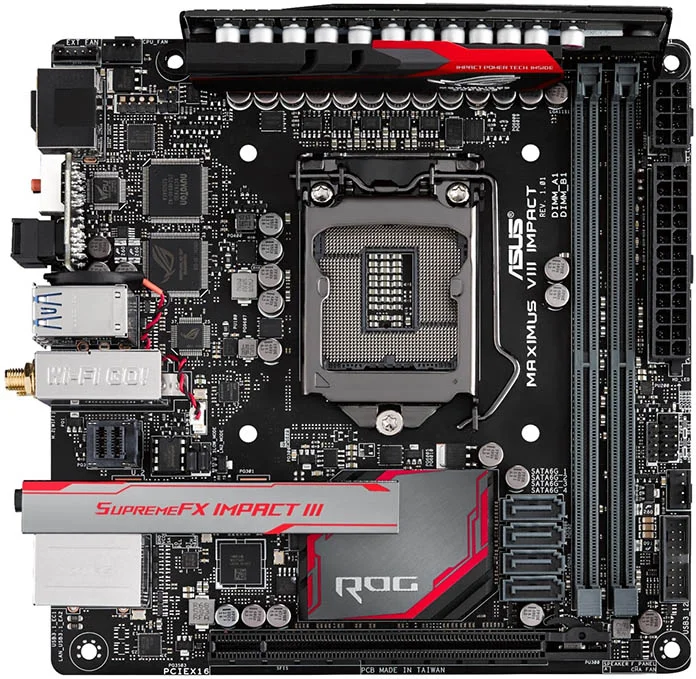
Frankly, we shouldn’t be surprised. The U.2 interface has four PCIe Gen3 lanes, just like current M.2 slots, but it uses a cabled connection that lets drives reside in standard cages, where they can benefit from natural chassis airflow. The larger form factor also leaves plenty of room for a heatsink to further aid cooling, and the 750 Series takes full advantage by integrating one into its shell.
We’ve long been aware of the benefits of U.2 storage, which is why native ports are integrated on several of our high-end motherboards, including the Maximus VIII Hero Alpha, Formula, and Extreme. The Z170-WS used in Puget’s testing has U.2 onboard, too, as do our latest X99-A II, X99-Deluxe II, Strix X99 Gaming, and Rampage V Edition 10. With the exception of the Maximus VIII Impact, all these boards also have M.2 slots.
If you still want to run an M.2 drive, the Puget’s companion post shows that a dedicated cooling fan or full-sized adapter card with heatsink can minimize throttling on the 950 Pro, if not eliminate it entirely. The company even sells the adapter, but Bach told us it tends to favor the 750 Series in desktop builds instead. The 950 Pro is used in notebooks, where there’s usually more ventilation—and no hot components in the immediate vicinity.
Serial ATA SSDs still outsell their PCIe counterparts by a huge margin—about 12:1 at Puget Systems—so it’s important to keep things in perspective. The fact is that SATA SSDs are fast enough for the vast majority of desktop applications. The one Puget System tested for throttling didn’t exhibit any, either.
Speaking of perspective, we should also reiterate that throttling was only evident under sustained loads. The 950 Pro takes some time to heat up, and outside of targeted benchmarks, most everyday storage loads are too short to trigger throttling. But we’d be critical of a CPU or GPU that behaved the same way, so it’s hard to give this story a positive spin. The best we can offer is a range of motherboards that situate their M.2 slots clear of potential hot spots, plus plenty of options with U.2 ports that let you avoid the problem entirely.

